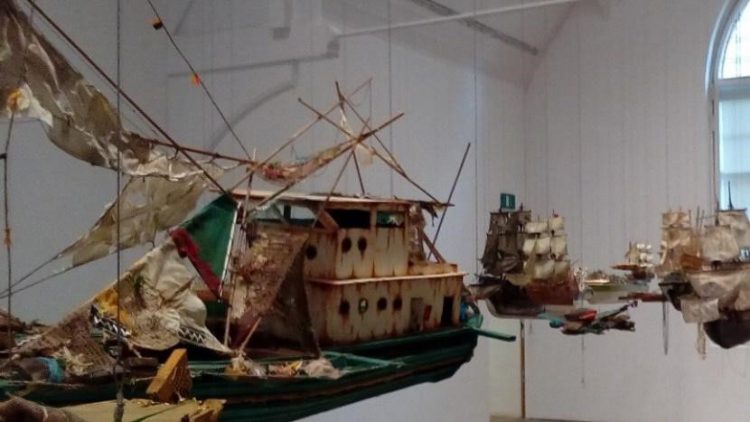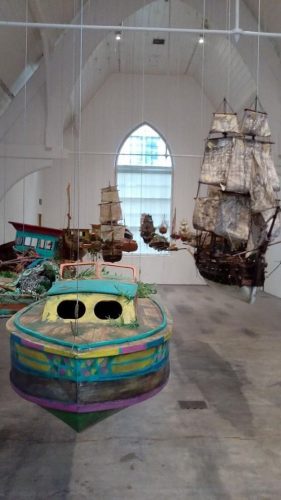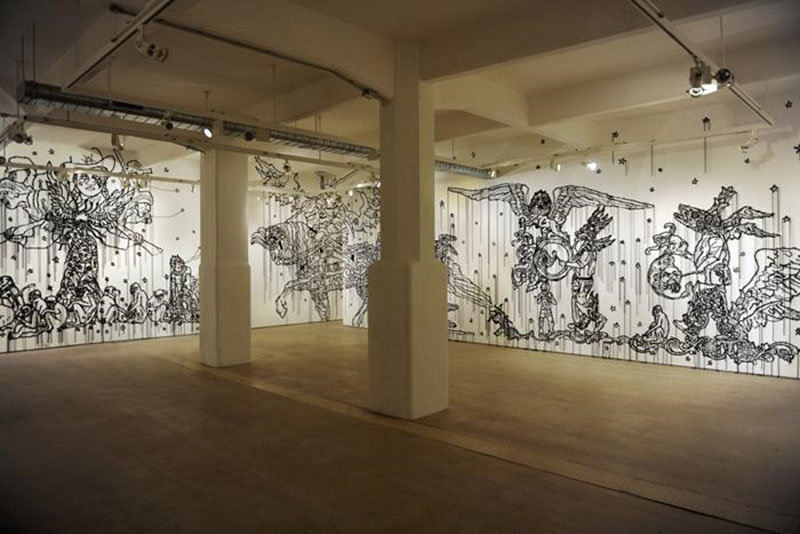

It really is a delightful experience to stand before or within artwork completely lost to how the particular creation came to be. No, I’m not referring to the material choices or the apparent skill in working said material, although those can be aspects of the delight. I’m referring to how the synaptic activity worked in the brain of that particular creator to decide, for instance, that filling an imposing white space with thick, dark, viscous and smelly sump oil was the way to go. Or better yet, stitching together moments from movies when the time was uttered or a clock or watch or another device of time was shown on screen or glanced at was worth investing hours of one’s time to make, and for this stitchery to last 24 hours with the viewing synchronised with actual time. Sitting on a bean bag before the large projection one was acutely aware of both the madness and the gloriousness of watching time literally pass in Christian Marclay’s The Clock. Equally poignant, emanating from the disjointed dialogue, was the reflection of our human preoccupation with time. Emotions changed with the passage of each minute and so did the narrative. Yet, the work transfixed and compelled attentive looking. I, for one, was happy for the strange synaptic activity that allowed this work to come into being.

Effective art lets the imagination take flight. No, there is no consensus on this, just as there is no consensus on what art is and how it should function. This is just my humble opinion about a necessary characteristic of good art; that it be effective. I read somewhere another artist’s requirement of good art; it should be large in scale. I smiled when I read that. That doesn’t mean I agreed. Like a good book on an easy, breezy Sunday afternoon, good art should allow one to transcend reality whether to a point of further ease or complete discomfort. With every successive exposure to it, good art should yield more of itself to the viewer. But should this latter aspect always be a necessary condition?
Encounters with art can be as delightful as walking along a forest path, unsure of where it may lead and suddenly stumbling on a serene pool of leaf-tinted black water. Oh, the joy of that encounter on a sweltering hot day! “… You are from Guyana? … Do you know Hew Locke? … You must meet him. I’ll take you!” I recall winding along grey streets covered by equally grey skies, brown and ochre brick buildings defining the way, and suddenly walking through a door into a white-walled space spectacularly covered by black beads on black cords. Black beads and cords hung against the wall forming human-like but not human figures, winged felines, and monkeys. Lots of monkeys in clusters on the picture’s ground. Giant four-legged creatures of an interesting variety promenaded along the wall as grand-winged creatures hovered above transporting equally mythical figures. Giants walked and beat drums and carried nondescript weaponry. I didn’t know what I was seeing. But I liked it. I felt I had left the uninspiring environs for a lost world.
The figures and the room were all strange and lacked specificity. Somehow, it made perfect sense that this should emerge from the mind of a man who had spent substantial time in Guyana. The work was not African, Indian, or indigenous but it was all that. Hybrid creatures, recalled for me our hybrid culture. Not clearly one thing or the other. The procession of figures, blindly following was eerily unsettling; bombastic drummers leading silent monkeys. According to Locke’s gallerist, “The Nameless sees a dense amalgamation of historical and contemporary references resulting in the combination of Venetian sculpture with Victorian architectural details, Pre-Columbian artefacts with Assyrian reliefs and heraldry with the Benin Bronzes.”
Years later, I made a solitary and deliberate journey to see Locke’s artwork in a city where I knew no one. By then, I knew Locke grounded his practice in a critique of colonialism and empire. With my poor sense of direction for spaces not laid out on a grid or defined by riotous natural growth, I got lost. Eventually, I found the gallery and I wandered into and out of the rooms. Some works were very specific to the nation space I was in. I struggled to connect. Some others were very specific to Guyana, yet relevant to former colonies of the British. Eventually, I walked into the room I had journeyed specially to see. I was awed by the flotilla of suspended boats beautifully laden with signs of use, abandon, and nature’s reclaim. I admit I did not read what was written about the work. It did not matter. I walked around the flotilla numerous times. Pausing as I made my circuitous journey to bend and peer, to tip-toe and peer. I was utterly enamoured. The boats at Parika came to mind. Boats abandoned and forgotten to time. Reminders of long arduous journeys. Distant, long-forgotten lands. Our perpetual battle to not be reclaimed by nature and our heady mix of dereliction and newness, past and present. Quite possibly, Locke did not intend any of what I saw. Or perhaps he did, recalling some traces of his boyhood psyche in Armada.
Over the last two weeks, I shared some of my art practice. I did so to establish that there are serious challenges to engaging in contemporary art practice in Guyana. Fundamentally, there is a lack of understanding and appreciation for the newer approaches that can be found at all levels of our art community – from enthusiasts who coordinate events to artists whose sensibilities and art practices were formed within traditional contexts. I did not allude to the following but sadly challenges to engaging in contemporary art practice also come from art educators who speak against what they fear or cannot understand about it. Consequently, I am not surprised that local artists refrain from engaging in anything that is not tried, tested, and found to be approved by the local arbiters of art.
Today, I draw my advocacy for installation art to a close (at least for now) by reflecting on works by Locke that I have physically experienced. I have not discussed his recent work. The Procession installed at Tate Britain from March 2022 to January 2023 because my knowledge of it is through copious pictures and videos friends shared with me or which I found online.
Akima McPherson is a multimedia artist, art historian, and educator






